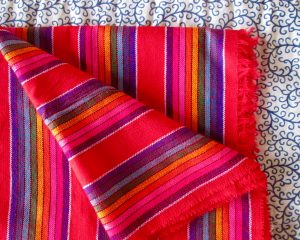My friend Toni, a lifelong political activist from New York, who has lived here in San Miguel de Allende, Mexico, for a dozen years now and who created Hats and Scarves for Campo Kids (a knitting/crocheting group I attend each Sunday afternoon [See WOW post “For the Kids” – Jan. 2, 2016]), has of late become passionately involved with aiding desperate migrants passing through this town.
Toni reports that they are arriving daily – emaciated, dehydrated, dirty, and traumatized – traveling on the roofs of freight trains that stop briefly in San Miguel. They are mostly young men, and some young women – Central American refugees fleeing the violence, poverty, and rampant drug warfare in their countries, and deportees stripped of everything and dumped back into Mexico from the U.S.
One of the ways that Toni and her team have mobilized to help these needy migrants is by forming the Train Tracks Migrant Relief Project (nicknamed Madrinas a los Migrantes, or godmothers to the migrants). This group of volunteers seeks out migrants near the San Miguel train tracks and elsewhere in town in order to supply them with small, lightweight packages containing such items as food (dried fruit, nuts, and energy bars, for example), hygiene supplies (such as small bars of soap and travel-size toothpaste and toothbrush kits), baseball caps, socks, t-shirts, light blankets, rain ponchos, and a map indicating safe houses, Red Cross stations, and the train track systems.
When I think about these young men and women fleeing – or being deported from – the only countries they’ve ever known, and the millions of other people labeled “refugees” in the world (more than 22 million, the highest number since WWII, I just read in the New York Times), my mind and heart ache with unanswerable, swirling questions:
What does it mean to belong to a place? Where can one safely go to find refuge when the bottom falls out of that place? Who draws the borderlines — or builds the walls or razor-wire-topped fences – and for what reasons? Aren’t we all immigrants – or immigrants-once-or-twice removed? Aren’t we all just passing through?

My grandparents on both sides were immigrants who found refuge in the U.S. in the early years of the last century. My paternal grandfather was an orphan who stowed away on a ship from Scotland to New York when he was in his early teens. He was “illegal,” but he wasn’t turned away when he arrived. He settled in Morristown, New Jersey, became a proud citizen, a good husband and father, a leader in his community, and a successful entrepreneur.
The issue of migration, as anyone who follows the news knows, has become a sizzlingly hot topic of late, especially in the wake of Trump’s bellicosity about the border wall. The pendulum swing toward nationalism and isolationism – in the U.S. (read: Trump) and even evident in Germany’s recent elections – has been more than alarming. What good does it do to build a high wall against one’s closest neighbor (and call that neighbor vile names), or slam heavy doors in the faces of those who seek asylum? What GOOD does that do?
In a poignant Op-Ed piece in yesterday’s New York Times (“The Wrong Time to Cut Back on Refugees,” Sept. 29, 2017), Michael G. Mullen, a retired US Navy admiral who is now on the board of Human Rights First, wrote, “Over the years, the United States has lived up to its ideals and brought millions of refugees to safety and freedom. It didn’t become a resettlement leader out of pure altruism. By welcoming refugees, the United States revitalizes its democracy and its economy, helps preserve or restore stability in volatile regions of the world, and builds respect.”
Mullen concludes his Op-Ed with: “More than any other resource — including military and economic might — this [support for refugees] accounts for American greatness. We sacrifice it at our peril.”
The young people running for their lives — and endangering their lives — by traveling north toward the U.S. on the roofs of freight trains passing through San Miguel de Allende are in grave peril. The good-hearted, well-meaning volunteers here in San Miguel – and elsewhere on the young migrants’ route – may well be helping them to survive their perilous journey. But how will they be met at the borderline? What will happen to them then? I shudder to think of it.
~ ~ ~
(To learn more about the Tracks Team and how you might contribute to this important humanitarian effort, contact Toni at Roberts_toni@yahoo.com. If you live in SMA, you can hear Toni participate in a Rotary presentation, “Mexico: Caught in the Middle Between Migrants and Deportees” on Tuesday, October 3 at 12:30 pm at the Hotel Mision, Salida a Queretaro 1.)
